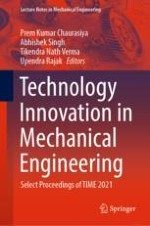This book comprises select papers presented at the conference on Technology Innovation in Mechanical Engineering (TIME-2021). The book discusses the latest innovation and advanced research in the diverse field of Mechanical Engineering such as materials, manufacturing processes, evaluation of materials properties for the application in automotive, aerospace, marine, locomotive and energy sectors. The topics covered include advanced metal forming, Energy Efficient systems, Material Characterization, Advanced metal forming, bending, welding & casting techniques, Composite and Polymer Manufacturing, Intermetallics, Future generation materials, Laser Based Manufacturing, High-Energy Beam Processing, Nano materials, Smart Material, Super Alloys, Powder Metallurgy and Ceramic Forming, Aerodynamics, Biological Heat & Mass Transfer, Combustion & Propulsion, Cryogenics, Fire Dynamics, Refrigeration & Air Conditioning, Sensors and Transducers, Turbulent Flows, Reactive Flows, Numerical Heat Transfer, Phase Change Materials, Micro- and Nano-scale Transport, Multi-phase Flows, Nuclear & Space Applications, Flexible Manufacturing Technology & System, Non-Traditional Machining processes, Structural Strength and Robustness, Vibration, Noise Analysis and Control, Tribology. In addition, it discusses industrial applications and cover theoretical and analytical methods, numerical simulations and experimental techniques in the area of Mechanical Engineering. The book will be helpful for academics, including graduate students and researchers, as well as professionals interested in interdisciplinary topics in the areas of materials, manufacturing, and energy sectors.
